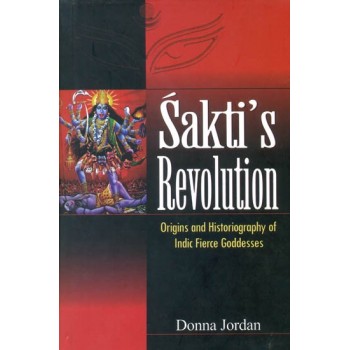Detail Of Sakti's Revolution
| ISBN | 9788121511926 |
| Pages | 515 |
| Language: | English |
| Product Code: | 1 |
| Size(in cm): | 10.0 inch x 7.0 inch cm |
| Weight(in grams): | 910(approx) |
Description:
Contents
Plates xiii
Preface xix
Acknowledgments xxxi
Abbreviations xxxiii
Part I
Origins 1
Introduction 3
The Question of Matriarchies 3
Defining Female/Male Dominance 3
Cherokee Matriarchy 5
Indian Adivasi Matriarchy 6
Myths Reflect Patriarchal Coup 9
The Shift to Agriculture 10
1 The Milieu of The Indus Culture: c. Third To First Millennia BCE 14
Tree Worship and the Holy Groves of the Goddess 14
Hathor 17
Asherah 17
The Tree Cult in India 19
Astral Imagery 22
Sacred Prostitutes 26
The Goddess and Her Cyclical Sacrificial Consort 28
The Demise of Shamanism, the Rise of the Military, the war Goddess, and the Law 34
Inanna 39
Ishtar 40
Anath 42
Law Codes 44
The Indus Valley Civilization 46
Indus Culture 49
Slaves and War 51
The Goddess and the Bull 52
The Fall 54
The Aryan Invasion Theory (AIT) 54
The Indigenous Aryan Argument 56
2 Warfare And Male Supremacy 64
Masters of War 66
Brahmanic Religion 70
Tamil Religion 71
Mazdean Religion 72
Judeo-Christian Religion 74
Islam 76
Divine Feminine Violence 77
Sati 80
The "Myth" of Women Warriors 86
3 Tribes 92
Resistive Dimensions of Tribal Religion 94
Mariyamman 97
Ellaiyamman 100
Deification of Suffering and Violent Death 102
Spirit Possession 109
The Nagas: A Modern Fertility and Skull Cult 112
Ritual Specialists and Sacrifices 115
Fertility and Megaliths 116
Head-taking 117
Warfare 118
Fertility, Agriculture, and Death 120
Christian Reforms 121
Fierce Tribal Goddesses in Sanskritic Literature 123
Archaic Tribal Festivals 127
Hookswinging (Covadi) 128
Navaratri/Dasahara Festival 129
Rites to Awaken Earth Mother 131
Tantrism 132
Part II
Historiography 141
4 The Early Tamils: The Cankam Age 143
The Tamil Country 143
The Religious Landscape 149
Feudalism, Divine Martial Law, and the Glories of War 151
Women and the Warrior Ethic 158
The Decline and Fall of the Heroic Bardic Mode 161
Ancient Tamil Sylvan Goddesses 163
Korravai 164
Aiyai-Kumari 169
Kannaki 170
5 The Early Aryans: Vedic Through Epico-Puranic Eras 177
The "Civilizing Mission" of Brahmanic Hegemony 177
Bourgeois Ideology 178
The Cast System 179
Conversion or Marginalization/Pauperization of Tribals 182
Mythic Legitimization of Tribal Oppression 186
Vedic and Post-Vedic Sylvan Goddesses 190
Nirrti 192
Laksmi 194
Aditi 195
Sita 195
Prthivi 195
Sarasvati 196
Durga 196
Kali 196
Raksasas 198
Apsaras 198
Grama-devatas 198
Birth Goddesses 198
City Protectresses 199
Disease Goddesses 200
Matrkas 201
Yaksinis 203
Mythic Assimilation and Dilution of Goddesses 205
Siva's Anti-Brahmanic Origin 208
The Accouterments of Aryan Warriors 210
Vedic Women 211
Proto-Sramana: The Wandering Mendicant 213
Vedic Metaphysics 215
The Earth-based Atharvaveda 215
Magic and Medicine 216
Expiatory Rites and Charms 218
Witches and Demons 218
Effigies, Spells, and Curses 219
6 Asceticism, Sramanism, And The Great Goddess Revival: c. 600 BCE-AD 300 227
Historico-Ideological Context of Sramanism 227
The Dialectic of Sramanism and Brahmanism 230
The Ideological Shift from Yajna to Ascenticism 233
The Buddha, Asceticism, and Class Society 237
The Ajivikas and the Jainas 245
Bhakti Cults 246
Sramanic Absorption of Indigenous Goddesses 248
Early Buddhism 250
Mahayana Buddhism 250
Vajrayana Buddhism 252
Jainism 253
7 Brahmanic Devaluation of Women Versus Liberation Symbology 258
The Vanishing Freedom of Women: Post-Vedic Period 258
Legal Treatises Governing Marriage and Inheritance 260
The Arthasastra 260
The Manusmrti 261
Mahisasura-mardini 273
8 The Rise of The Sakta Counter Culture The Classical Period (AD 300-700) 279
The Historico-Religious Preconditions 279
Social Surplus and the Subaltern Temple Builders 281
Sakti's Counter-Culture 283
Buddhism 284
Tantrism and Saktism 285
Puranic Literature, Brahmanic Property, and Land-Grants 287
Literary and Archaeological Evidence 288
The Yogini and Kapalika Cults 289
Asceticism: The Repossession of the Body 292
9 The Flowering of Esoteric Yogic Cults Amid Islamic Invasions: The Early Medieval Period (AD 700-1300) 297
The Rise of Islam 297
Pre-Islamic Semitic Polytheism in Arabia 297
Muhammad and Islam 302
Islam in India 308
Gender and Caste Oppression 311
Yogic Cults of the Kaula Marga 314
A Tantric Catalogue 315
Kaula Marga as Anarchy 316
The Yogini Cult 320
The Kapalika Cult 328
The Natha Cult: Gorakhanatha and the Eighty-four Siddhas 342
Buddhist Siddhacaryas of the Sahajiya Cult 347
Vajrayana Buddhists 351
10 The Medieval Cakrapuja 372
The Elements of Cakrapuja 372
11 The Late Medieval Period (AD 1300-1700) 378
Male Sacrifice to the Fierce Sakti 380
12 Fierce Goddesses In Modernity 385
The Birth of Modern Hinduism, the Thrust of European Empire 385
Adivasis under British Colonialism 389
Bharata Mata and the Freedom Movement 395
13 Sakti In The Global Village 400
The Power of Collective Women 401
All Our Goddesses are Armed 403
Islamists and Maoists 405
The Martyr 407
Kali in Wartime 410
The Progressive Potential of Goddesses 413
The Feminist Dimension of Folklore 417
Epilogue 426
Bibliography 428
Index 472
Reviews (0)
Write a review
Your Name:Your Review:
Note: HTML is not translated!
Rating: Bad Good
Enter the code in the box below:



 |
| 